Service area: Children
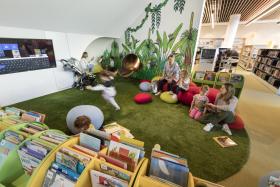
Children have different needs to other library users.
The children's area in a library caters for the needs and interests of children and their care givers, acknowledging that they have different functional requirements to the rest of the library building. These relate to activities and collections, as well as different learning, developmental and socialisation behaviours to address. Extending this understanding to cater for different developmental stages, recognising that a school age child has vastly different needs to a toddler, increases a library’s relevance and enjoyment for children.
Traditionally, these competing needs have been managed in the timing of programs, e.g. baby rhyme time during school hours, homework help after school. Management is critical given space limitations but there is great opportunity to truly inspire children to explore, interact and learn in a physical environment suitable to their age. Public libraries have traditionally played a pivotal role in early literacy, and as such the children’s area should be as inspiring as possible while including quiet reading spaces and areas for interaction and noise. Some dedicated children’s libraries, recognising that different age groups do not necessarily coexist happily, provide distinct areas for different age groups.
Children's experience
Library staff have sought inspiration from a range of sources to create better experiences in libraries tapping into children’s inquisitive and imaginative nature. Contemporary children’s library staff understand that communication through words is preceded by many other forms involving all the senses – the need to touch, experience colour, light and sound, to play, draw, and recognise symbols. Increasingly libraries are developing programs, services and collections to meet the needs of children with special needs or sensory challenges.
Flexibility
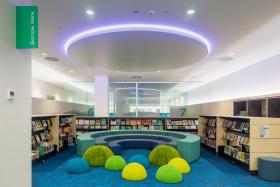
Providing flexible space for children’s programs is essential. The layout of a successful children’s area should be designed to cater for increases in group size by allowing activities to temporarily expand into adjacent areas that are not in high demand. Many children’s areas are well served by being closely located to meeting/function spaces, group study or working tables that can be used when needed. This ensures that even a modestly sized children’s area is capable of providing for more children should the need arise.
Selecting furniture on wheels, particularly shelving units, allows spaces to be quickly and easily reconfigured. Larger pieces of joinery can also be mobile if designed safely with wheel locking. Consider weight and handling procedures for larger items. Large numbers of prams can be accommodated by moveable furniture although some libraries provide dedicated areas for pram parking, where space constrictions are not an issue.
Fixed furniture can limit the activities in children’s areas. These items should be carefully considered to ensure flexibility in the longer term. Allowing the floor finish to continue under fixed items and designing large items as a series of smaller modules will allow greater potential for future reconfiguration.
Catering for large, noisy groups
The popularity of good children’s library space can lead to issues including:
- noise and separation from other areas – consider physical separation of space or significant acoustic absorption in building materials as well as separation by collection shelving
- activity spilling into other areas due to lack of space – ensure noise sensitive areas are planned away from the children’s area
- spaces which do not adequately contain small children during story or rhyme time – consider using meeting rooms or operable walls
- pram storage and ensuring free and safe egress maintained from all areas – a strategy will need to be developed to manage the storage of prams ensuring fire egress paths are maintained.
Safety
It is difficult to foresee everything that may pose a hazard to children during the planning and design of a library, however, some important elements to identify include:
- any hazards at toddler head height such as sharp corners on tables, or holes which fingers may get trapped in
- anything that children can climb on and fall from including shelving units
- any furniture which can tip over when climbed
- location of power points
- any surfaces that children can slip on including floor lights
- small parts, which can become dislodged and cause a choking hazard
- locating items which are supposed to be reached at a reachable height for children.
Display and signage
Storytelling and communication is not only in words – consider art, toys, tactile installations, digital media and performance. Provide for adequate display of themes and children’s work through pin boards, suspension cables or projection. Cataloguing and shelf signage that includes images rather than alphanumeric characters may allow children to navigate without help.
Children's IT and electronic games
Opinion regarding children’s IT areas varies. Some libraries avoid computer use altogether believing that there is now adequate computer access in other locations. They provide a range of traditional activities in comfortable settings. In libraries providing computers and tablets for children’s use the range is from totally open access, relying on parental supervision through to controlled access. The children’s area should be designed to allow easy supervision of computer use. Like adult libraries, children’s libraries can now offer information in a range of formats. Exploring and learning can take place in digital and hardcopy formats simultaneously, suggesting that the two should be highly integrated.
Electronic games areas are met with similar varied opinion. Accepting that libraries are now recreational spaces for children has allowed some libraries to create successful and customised gaming areas. Gaming areas should function as gateways for accessing books and other educational materials or be educational in themselves.
Toy Library
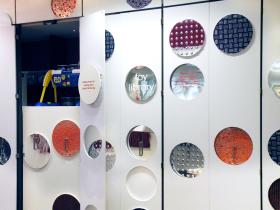
Toy libraries require a significant investment of space either near the children’s area or back of house. If located near children’s areas, precautions should be made for safety if children are accessing the collection themselves, especially in terms of shelving and door selection.
When open, the toy library collection can generate large crowds, including parents/carers with prams, which should be addressed in the design and location of the toy library. Safety, in terms of tipping elements, trip hazards, floor finishes and climbing, also needs to be addressed.
Storage
Ensure provision of adequate storage for children’s activity equipment and nearby library staff preparation space which can be safely left. It may be appropriate to have storage in the children’s area, staff work area or both.
Floor coverings
Consider floor coverings which can easily be replaced when stained, such as carpet tiles. Floor coverings which allow for craft and messy activities, such as linoleum, may not be comfortable for rhyme time and floor activity. Small mats or cushions can be used for comfort.
Furniture
Chairs, tables and bookshelves should be engaging and appropriately sized for children. There should also be a variety of seating options, including comfortable floor seating such as floor cushions, padded surfaces and individual carpet pieces. Shelving can be customised to allow children to explore, crawl, climb and find their own space. It can include niches and lookouts along with space for books. Families spend significant time in the children’s area so comfortable seating for adults and older children to read stories to younger children is necessary.
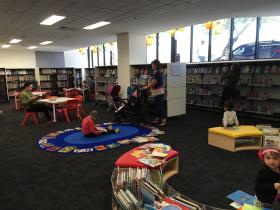
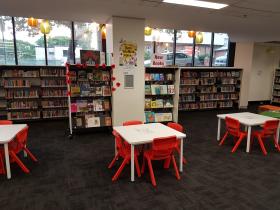
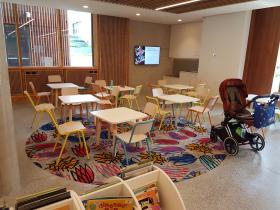
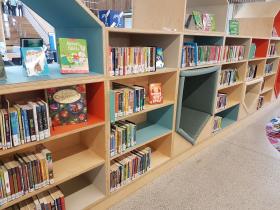
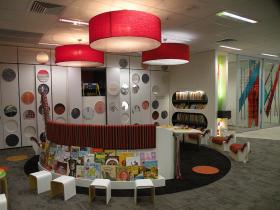
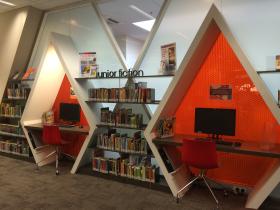
Outdoor space
A high-quality, safe, well shaded outdoor space for children to play and explore, as well as read can be an asset to a library building. It is ideal to have this directly accessible from the children’s area. There is educational value in exploring play equipment, sustainable gardens, food crops, smells and senses.